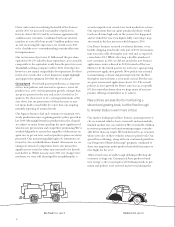Progressive 2011 Annual Report Download - page 21
Download and view the complete annual report
Please find page 21 of the 2011 Progressive annual report below. You can navigate through the pages in the report by either clicking on the pages listed below, or by using the keyword search tool below to find specific information within the annual report.
22
Our Snapshot® discount national introduction went as well
as we could have hoped for. Close to half of U.S. consumers
are now aware of Snapshot and the percentage of our new
customers that opt-in continues to grow. Almost 20,000 of
our agents are now trained and certified to sell Snapshot and
up-take amongst agents continues to grow as well. We are
now quite efficient in the mechanics of the Snapshot experi-
ence and we are getting some benefits of scale. Our expense
ratio specific to our usage-based programs was down approx-
imately
40% in 2011 versus 2010. At the aggregate level, we
also closely manage Snapshot profitability via the distribution
of discounts awarded based on driving performance. Suffice
it to say, we think our leadership with usage-based rating
in the minds of consumers and in our operational abilities
grew materially in 2 0 11.
The digital world continues to expand and we are working
hard to ensure our consumer and agent-facing technology
keeps pace with developments and adoption. During the
year, we expanded our mobile functionality in quoting,
buying, and servicing, and the adoption rate has been im-
pressive. A significant and quickly growing portion of our
quotes, sales, bill payments, and policy changes are being
transmitted via mobile devices and we expect this trend to
continue. We remain committed to meeting customers’
needs where, when, and how they wish to interact with us.
During 2 0 11, we introduced the ability to scan a vehicle identi-
fication number with the camera on a mobile device and allow
users to see how much it might cost to insure the vehicle.
We expect this and other “mobilized” features to become an
integral part of the experience we offer going forward.
Meeting our customers’ broader personal lines insurance
product needs is a key tactic for us and we are making excel-
lent headway here. When a household purchases more than
one product through us, our retention of that household is
considerably higher than similar stand-alone policies. Our
Progressive Home Advantage® program, where we “private
label” other companies’ property insurance products, continues
to grow rapidly. Early in the year, we elevated functionality
on our direct-to-consumer quoting platform that allows
con sumers to quote their auto and home/condo/renters in-
surance in a unified experience. We are also working with our
agents to consistently provide them similar bundled quoting
capabilities with us. Consumers are increasingly aware of
our ability to meet their broader needs and our results show
there is strong demand for this offering from Progressive.
Our priorities for 2012 are consistent with 2011
—
retention
and cost structure improvement, further penetration of
multi-product households, further expansion of our mobile
capabilities, extending our lead in usage-based rating, and
ensuring our people thrive and grow in a great place to work.
Commercial Auto Progressive’s Commercial Auto business had
another year of solid profits and a return to top line growth.
Our calendar-year combined ratio was 90.9 with a positive
change in net premiums written of 6%. For the year, earned
premiums, which follow the growth in premiums written,
were down less than 1%, but turned positive in August. Ex-
pense management allowed us to lower our Commercial
Auto expense ratio to 22 points, against flat earned premiums,
all while incurring the cost of hiring additional staff in
advance of anticipated growth.
These results were particularly satisfying in light of the pro-
longed market contraction experienced by the commercial
auto industry since 2006 and affirmed our commitment to
maintaining underwriting profit discipline through the soft
market. By comparison, the commercial auto industry written
premium grew a modest 0.4% through the first three quarters
of 2 0 11 and the industry loss ratio deteriorated 6 points. We
anticipate the final industry premium numbers will show
low single digit growth, a slight but welcome shift from four
years of decline, and further deterioration in the loss ratio.
The positive business momentum we built throughout the
year combined with some improvement in the general
economy are encouraging signs as we enter 2012.
Top line growth was driven by a healthy increase in written
premium per policy of 5%. We raised rates in most states
and on all business tiers in the first half of the year without
undue adverse impact to policy retention. The most im-
mediate effect of the price increases was, as anticipated, a
decline in new business conversion rates. This was in part
offset by increased demand in the for-hire transportation,
tow, and contractor business market targets. For the year, new
business applications were down 2% and policies in force
were essentially flat. Those numbers obscure the positive
trends which emerged in the second half of the year with
solid growth in new applications (+3%) and improving year-
over-year trends in policies in force. We continued to take
targeted rate increases throughout the rest of the year and
ended well positioned on pricing relative to underlying
loss cost trends. We would hope to see considerable volume
upside if market prices begin to move in the direction
industry results suggest they should and many industry
observers anticipate.
Truck (Wata, age 34) VW GTS 1989 (Mauricio, age 35)
























